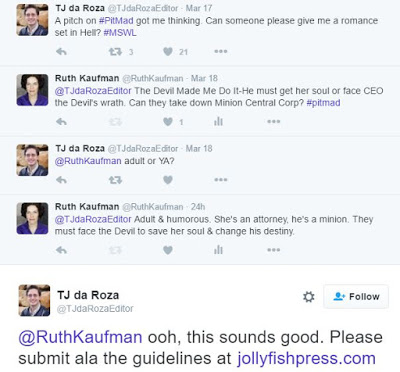As you can see, I haven’t blogged in years, in part because I’d decided to switch to a newsletter. Some authors and other professionals manage to create successful newsletters, but factors including the monthly cost (compared to my minimal book sales) while endeavoring to add subscribers, ever-changing privacy compliance rules and not releasing more new books helped me decide to return to blogging to communicate with anyone interested. [Read more…] about What is writing success?
Pitching to agents & editors on Twitter
Back in the day, if you wanted to learn about literary agents and book editors so you could submit your book for representation or publication, you had to go to a library or buy a book listing such information, without knowing if the information was still current.
Then, as now, you could also attend conferences to hear them speak and/or meet them in person for up to the minute info, but that can be expensive and time-consuming.
Then came the Internet, where agency websites that often list agent bios and interests. Publishers have sites, too, but information about individual editors can be hard to find. And sites might not be updated frequently…despite a fast-changing market. For example, I just checked a publisher at random whose site still has Fall 2015 editor interests. Sites like QueryTracker can be great for agent info, assuming the profiles are up to date. But the onus is on you to search, and the genres are often quite broad, such as romance.
Then came Twitter, where authors could follow and interact with agents and editors. (For some reason, in my experience, Facebook didn’t catch on for this purpose.) Even better, those industry professionals can let authors know exactly what they’re looking for in real time.
Popular hashtags are #MSWL, manuscript wishlist, where editors and agents post in detail the projects they’d love to see and #PitMad, where author Brenda Drake holds quarterly events during which authors tweet pitches by following her rules. If an industry professional likes the tweet, the author can submit (usually by following instructions on the agent’s site or given in a reply tweet).
 There are other pitch parties, too. A recent event was #PitMatch, where Cupids matched tweets on #MSWL and #PitMad. I was fortunate that a dream agent favorited my tweet. I submitted 5 pages as her site instructed, and within a few days her assistant requested the first three chapters, then she herself requested the full. Fingers crossed!
There are other pitch parties, too. A recent event was #PitMatch, where Cupids matched tweets on #MSWL and #PitMad. I was fortunate that a dream agent favorited my tweet. I submitted 5 pages as her site instructed, and within a few days her assistant requested the first three chapters, then she herself requested the full. Fingers crossed!
I popped online to browse #MSWL, the other day, and came across an editor who wanted a romance set in Hell. Well, I just happen to have one. I replied to his tweet, he asked a follow up question…and requested.
Of course, as with any type of pitching, there’s no guarantee of representation/a sale, or even going further than the initial submission. But Twitter pitches are a great way to connect quickly with agents and/or editors.
This approach saves authors significant time. If someone is interested, you’ll know soon, maybe within minutes or hours. I’ve met many authors who are terrified to pitch in person, so Twitter bypasses that fear. Plus, your query/submission isn’t unsolicited as it would be if you just queried as their websites instruct. The agent/editor is already aware of your project and asked to see it.
Happy pitching!
